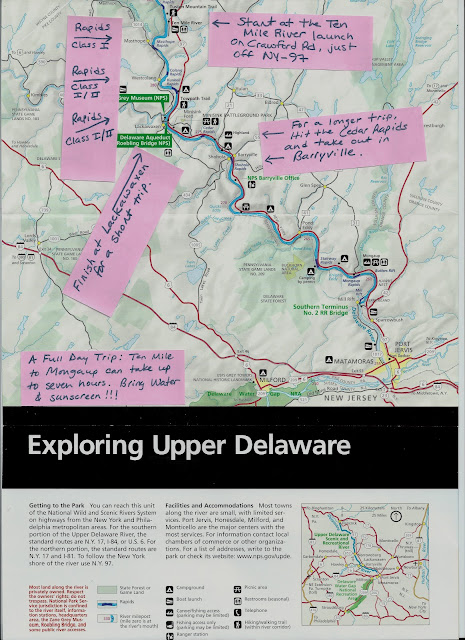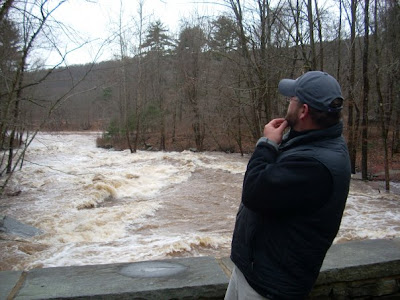By a stroke of dumb luck we planned our trip to Virginia in mid-May over a weekend that coincided with the annual anniversary celebration at Jamestown. Special events were taking place at both Jamestown Settlement, a living history attraction administered by the Commonwealth of Virginia and at Historic Jamestowne, which is a part of the US National Park Service. We chose to start the day at Jamestown Settlement and made it there just in time to watch the
Godspeed, a recreated 17th century brigantine, depart from port for a cruise on the James River. Due to the cruise we were not able to tour the
Godspeed, but three other ships were open for exploration. The largest,
Susan Constant, was where I spent most of my time.
 |
| Galley and cook's quarters on board the Susan Constant |
Touring the ship was fun. Had I been a crew member back-in-the-day I would have opted to be the cook. He got his own bed in the galley. Not only was it private, but was probably the warmest place on board the ship. It was also not below decks, and given the conditions of travel and lack of hygiene in the 17th century. I think it would have been the best quarters possible.
Here, like Williamsburg, the staff was clad in period clothing but wasn't living in the past. They spoke in modern language and were able to answer questions and give presentations that were interesting and easy to follow.
After touring the ships we headed over to where the artillery demonstration was taking place. Honestly, I just had watched a similar demonstration the day before at Colonial Williamburg, and aside from the cannon and a few commands, it wasn't all that different...but really, how does one pass up the opportunity to watch a cannon drill?
Following the drill we made our way to the recreated village. My wife was interested in the garden planted outside the palisaded hamlet. She noted the extremely large rosemary bushes. I busied myself attempting to get a decent picture of the free roaming rooster that was darting here and there...no luck. The bird wouldn't hold still long enough for the shutter to click. So we headed through the gate to have a look around inside the village.
 |
| Typical building style in Jamestown |
What struck me was that most of the buildings were rather well built for the period they were trying to recreate. I was expecting log cabins or frame houses made with rough-cut siding. Nope. The earliest of the Jamestown settlers lived in such shelters only long enough to build structures akin to what they were used to back in England. The craftsmen who arrived in the New World were used to constructing Tudor and Elizabethian style buildings, so that's what they built. While some had stone or wood floors, simple dirt was the norm. Still in all. They seemed cozy and well made. Aside from the homes, we toured the storehouse, smithy, armory, and apothecary. In most cases there were interpretive staff members giving demonstrations or lecturing about daily life in early 17th century Virginia.
 |
| Inside a Jamestown home |
Outside the palisade and a few dozen yards away was the recreated Powhatan village. On display were several huts, lavishly decorated with furs and tools, that would have been commonly found in homes of the indigenous people living there in the early 1600s. Native American lore is a hobby of mine and having led programs on the subject for many years at summer camps, I needed no tour guide as I went from hut to hut. I easily recognized most of the items, albeit I noted the differences between what the Powhatan used and what I was familiar with from the Lenape and Iroquios. Here, arrow quivers were woven from sticks instead of being made from leather. The baskets were differently shaped from what their neighbors to the north used and some of the tools were shaped or sized in a different manner. However the similarities between daily life among the Powhatan and other Eastern Nations were easy to spot. Crops were growing, leather was being stretched and scraped to form it into leather, and people were constructing tools and arrows.
 |
| Pohatan dwelling with cooking rack in foreground |
Following our trek through the Powhatan village, we headed back to the welcome center. Before lunch we took in a short film about the construction of the Godspeed replica. Just last year I had watched a wooden ship being built at Mystic Seaport in Connecticut, and the movie made me remember the sights and sounds of a shipyard there. Modern tools were used in both cases, but old techniques and tricks of the trade are still employed in wooden shipmaking. Interesting more was the segment on sailmaking and rigging. I'm not a sailor nor am I a naval buff so I'm easily impressed by those that understand sailing. I was awestruck to see the amount of work and the attention to detail needed to construct canvas sails and rigging.
Following the film we ate a quick lunch at the welcome center cafeteria. The variety of food was impressive. I opted for a barbecue brisket sandwich, which was pretty good but somewhat overpriced, even for a tourist area. The french fries tasted like typical SYSCO stock. Two lunches with drinks and a small dessert cost us almost $30. Other dining options are quite a drive away, so if you are on a budget I suggest packing a picnic lunch if possible.
Our afternoon activities lay a short drive away. Just up the road is the
National Park Service's Historic Jamestowne (aka Jamestown National Historical Site.) Like most facilities of the NPS, a modest visitor center offers some displays and an orientation film about the area. Outside was something different than any other park I had visited before. For all intents purposes, the place is a full-time archaeological dig. Yes, there are remnants of buildings and a few monuments, but here you can actually see archaeologists working. At the far end of the park, which isn't very large, is the
Archaerium, a museum housing the artifacts that have been recovered during the digs. It contains everything from shards of old tools to nearly complete skeletons. The archaeologists come and go from this building as well, often speaking with the staff about the days finds and what's planned for tomorrow. They and the museum staff are quick to answer questions and even show off artifacts.
 |
| Old church at Jamestown National Historical Site |
We walked the grounds for some time exploring the old church and looking at the monuments before heading over to watch the afternoon musketeer drill provided by the
St. Marie's Citty Militia. The group was small, but demonstrated 17th century pike and musket drills. Like their counterparts at Jamestown Settlement, they too are dressed in period. When one thinks of colonial America images of men in tricorner hats usually comes to mind, these folks looked more like the men on the Dutch Masters' cigar box. Their tactics were of the late Renaissance and they carried matchlock muskets. There was a bit of marching and explanation about drums and flags but the main attraction was the musket drill.
Both parks are well worth seeing. Leave more time for the Settlement. If you are new to living history exhibits, you may need five hours or so if you haven't seen things like a blacksmith or an armorer working a forge before. Even a seasoned historical explorer should leave about four hours, especially if you have chance to tour the ships or wish to watch the militia. If there is nothing special going on at the National Historic Site, two and half hours should be ample time to visit there. Granted if you want a ranger led activity or wish to see the archaeologists in action, extra time might be needed. Both parks are included if you purchase a Historic Triangle package or you may simply pay the daily entrance fees if Jamestown is your only stop in the area.
 |
| The Godspeed under sail on the James River |






















